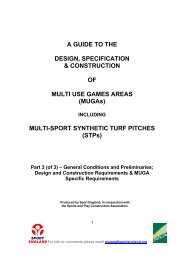View - North East Lincolnshire Council
View - North East Lincolnshire Council
View - North East Lincolnshire Council
You also want an ePaper? Increase the reach of your titles
YUMPU automatically turns print PDFs into web optimized ePapers that Google loves.
BOC Immingham Dissolved Acetylene Project Environmental Statement: Vol. 2 Main Text<br />
Land Contamination Risk Assessment<br />
Conceptual Site Model<br />
7.30 Land contamination can present an unacceptable risk to a proposed development, or the<br />
proposed development itself may increase a risk that existing land contamination already poses.<br />
Therefore, a preliminary conceptual site model (CSM) has been prepared to aid in the<br />
identification and assessment of potential impacts and associated effects of the proposed<br />
development and any land contamination that may be present. A CSM describes the relationship<br />
between potential sources of contamination (resulting from both on site and offsite historical and<br />
recent activities) and receptors to the potential contamination. As part of the CSM development,<br />
three elements, the source of contamination and associated contaminants, receptors to that<br />
contamination and the pathways between the two are identified and assessed. Where all three<br />
elements are present or are likely to be present, they are described as potential pollutant linkages<br />
(PPLs). Identification of PPLs, also called source-pathway-receptor linkages, underpins the CSM<br />
and enables the potential risk posed by any contamination to be assessed and thus, potential<br />
impacts and effects to be identified.<br />
UK Guidance and Approach to Land Contamination<br />
7.31 Primary guidance for assessing and managing land contamination is presented in CLR 11 35 . The<br />
process of contamination risk assessment as defined in CLR 11 35 includes:<br />
� developing a preliminary CSM by a desk study review of available documentary information<br />
and identifying the potential hazards sources, pathways and receptors relevant to the site<br />
and the PPLs which may be present;<br />
� gathering site-specific information on the CSM through site investigation to identify the<br />
presence, nature, potential concentrations and spatial distribution of contamination, details of<br />
pathways for migration of contamination and specific information on the receptors to update<br />
the CSM; and<br />
� risk assessment by applying criteria that will enable a judgement as to whether the<br />
concentrations of contaminants represent an unacceptable risk. These criteria must be<br />
relevant to each PPL and can be generic or site-specific. Generic assessment criteria are<br />
concentrations of a contaminant below which the risk is acceptable. Site-specific assessment<br />
criteria are concentrations of a contaminant above which there is likely to be an unacceptable<br />
risk. If a site fails on the site-specific assessment criteria, remediation may be required.<br />
7.32 The process of contamination risk assessment as defined in CLR 11 35 has been adopted as<br />
follows:<br />
� hazard identification (establishing contaminant sources) and hazard assessment<br />
(establishing pathways and receptors and identifying PPLs). Both the hazard identification<br />
and assessment stages conclude in development of the CSM;<br />
� risk estimation which predicts the likelihood (probability assessment) and degree<br />
(consequence assessment) of harm pollution occurring. Risk estimation has two<br />
components: firstly probability assessment which relates to whether pollution harm will occur<br />
in the short and or long term (risk estimation is only undertaken when a PPL exists); and<br />
secondly consequence assessment which is the magnitude of harm that would occur<br />
because of the PPL, that is, the degree of harm pollution considering the sensitivity of the<br />
receptor. Therefore, the consequence is whether the PPL would be a significant pollutant<br />
linkage; and<br />
� risk evaluation which is the process of deciding whether a risk is acceptable or not and<br />
entails the application of evaluation criteria. These evaluation criteria are set in relation to a<br />
level of harm or pollution to the specific receptor. They may be absolute standards or<br />
recommended limit values, for example, a health criterion value for the intake of a substance.<br />
5100935.404 Environmental Statement August 2011 95




